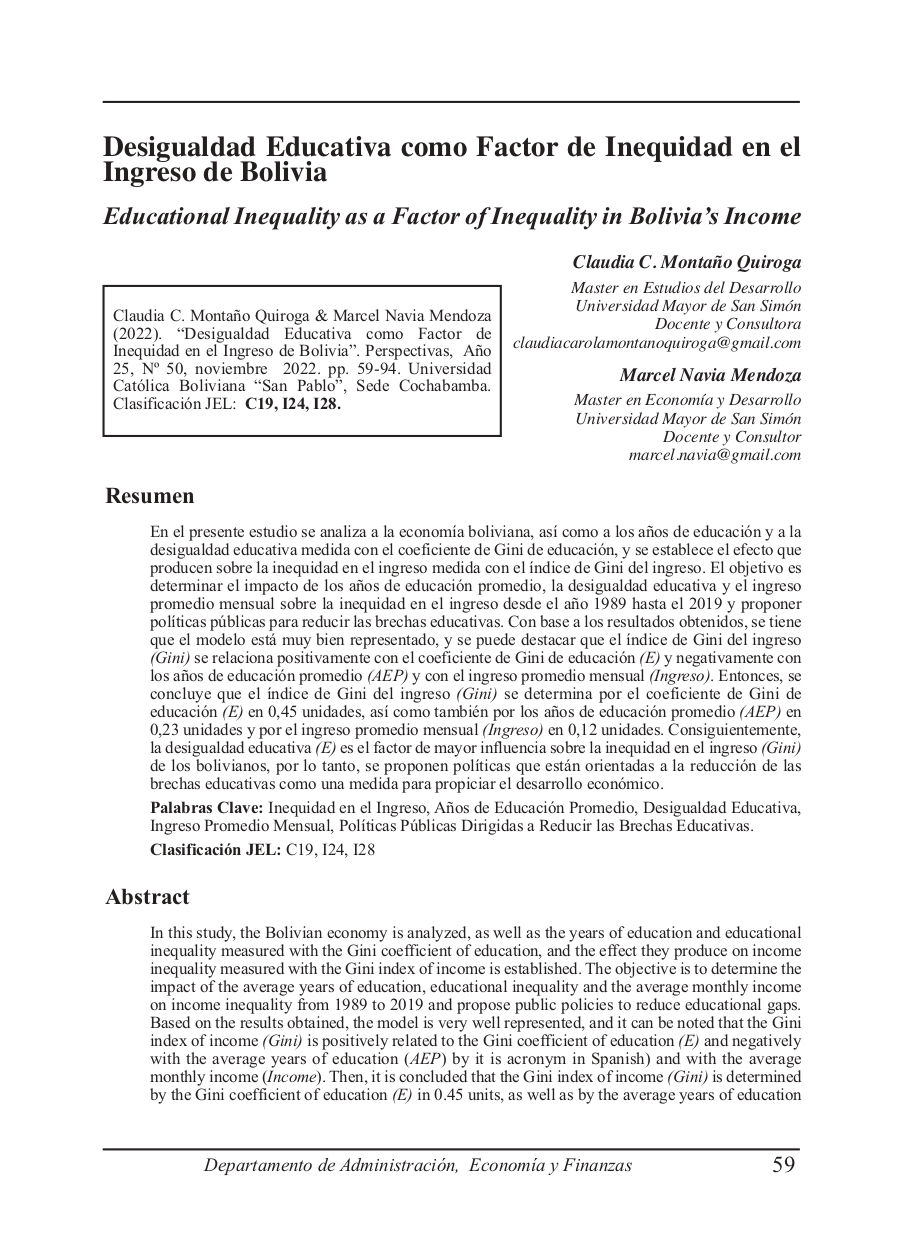Educational Inequality as a Factor of Inequality in Bolivia’s Income
DOI:
https://doi.org/10.35319/5mskn777Keywords:
Income Inequity, Average Years of Education, Educational Inequality, Average Monthly Income, Public Politics Aimed at Reducing Educational GapsAbstract
In this study, the Bolivian economy is analyzed, as well as the years of education and educational inequality measured with the Gini coefficient of education, and the effect they produce on income inequality measured with the Gini index of income is established. The objective is to determine the impact of the average years of education, educational inequality and the average monthly income on income inequality from 1989 to 2019 and propose public policies to reduce educational gaps. Based on the results obtained, the model is very well represented, and it can be noted that the Gini index of income (Gini) is positively related to the Gini coefficient of education (E) and negatively with the average years of education (AEP) by it is acronym in Spanish) and with the average monthly income (Income). Then, it is concluded that the Gini index of income (Gini) is determined by the Gini coefficient of education (E) in 0.45 units, as well as by the average years of education (AEP) in 0.23 units and by the average monthly income (Income) in 0.12 units. Consequently, educational inequality (E) is the factor with the greatest influence on income inequality (Gini) of Bolivians, therefore, politics are proposed that are aimed at reducing educational gaps as a measure to promote the economic development.
Downloads
References
Barro, R., & Lee, J. W. (December 1993). International Comparisons of Educational Attainment. Journal of Monetary Economics, 32(3), 363- 394.
Brugué, Q., Gomà, R., & Subirats, J. (2002). De la Pobreza a la Exclusión Social: Nuevos retos para las políticas públicas. Revista Internacional de Sociologia, 60(33), 7-45. Obtenido de https://revintsociologia.revistas.csic.es/index.php/revintsociologia/article/view/728
Hadri, K. (2000, October). Testing for Stationarity in Heterogeneous Panel Data. The Econometrics Journal, 3(2), 148-161. Retrieved from https://www.jstor.org/stable/23114886
Hujo, K., & Bauerová, J. (2011). Combatir la pobreza y la desigualdad: Cambio estructural, política social y condiciones políticas. Ginebra: Instituto de Investigación de las Naciones Unidas para el Desarrollo Social (UNRISD). Obtenido de https://repository.globethics.net/bitstream/handle/20.500.12424/188218/sintesis_combatir.pdf?sequence=1
Instituto Nacional de Estadística (INE). (2019). Glosario de Terminología Estadística. Obtenido de https://www.ine.gob.bo/index.php/descarga/222/glosario-de-terminos/38104/b-glosario-de-terminologia-estadistica.pdf
Instituto Nacional de Estadística (INE). (10 de Diciembre de 2019). Pobreza y Desigualdad: Información Técnica. La Paz.
Instituto Nacional de Estadística (INE). (7 de Diciembre de 2020). Bolivia: Ingreso Promedio Mensual en la Ocupación Principal por Sexo, según Características Ocupacionales, 2011 - 2020. Estadísticas Económicas: Ingresos. La Paz. Obtenido de https://www.ine.gob.bo/index.php/estadisticas-sociales/empleo-mercado-laboral/encuesta-de-hogares/
Instituto Nacional de Estadística (INE). (2021, Noviembre 21). Base de Datos Encuestas Sociales. Retrieved from https://anda.ine.gob.bo/index.php/catalog/93
Instituto Nacional de Estadística (INE). (7 de Diciembre de 2021). Bolivia: Tasa de Alfabetismo en la Población de 15 Años o más de Edad por Sexo, Según Departamento, 2011- 2020. Estadísticas Sociales: Educación. La Paz. Obtenido de https://www.ine.gob.bo/index.php/encuesta-de-hogares-educacion/
Instituto Nacional de Estadística (INE). (5 de Diciembre de 2020). Bolivia: Tasa de Asistencia de la Población entre 6 y 19 Años de Edad por Sexo, Según Área, 2011- 2019. Estadísticas Sociales: Educación. La Paz. Obtenido de https://www.ine.gob.bo/index.php/encuesta-de-hogares-educacion/
Instituto Nacional de Estadística (INE). (21 de Noviembre de 2020). Estadísticas Sociales: Encuesta de Hogares. Obtenido de https://www.ine.gob.bo/index.php/encuesta-de-hogares-educacion/
Instituto Nacional de Estadística (INE). (21 de Noviembre de 2021). Encuestas de Hogares: Ingreso Laboral de la Ocupación Principal. Obtenido de https://www.ine.gob.bo/index.php/encuesta-de-hogares-eh-2021
Levin, A., Lin, C.-F., & James Chu, C.-S. (2002, May). Unit Root Tests in Panel Data: Asymptotic and Finite-Sample Properties. Journal of Econometrics, 108(1), 1-24.
López, R., Thomas, V., & Wang, Y. (1998). Addressing the Education Puzzle: The Distribution of Education and Economic Reform. Policy Research Working Paper(2031).
López, R., Thomas, V., & Wang, Y. (1999). Addressing the Education Puzzle: The Distribution of Education and Economic Reform. Washington, D.C.: The World Bank.
Maas, J., & Criel, C. (1982). Distribution of Primary School Enrollments in Eastern Africa. (T. W. Bank, Ed.) World Bank Staff Working Papers(511).
Martínez, J., Hernández, J., & Valles, H. (2015). Educación y desigualdad del ingreso en municipios del estado de Chihuahua. Revista de investigación Educativa de la Rediech, 1(9), 77-83.
McKay, A. (2002, March). Defining and Measuring Inequality. Inequality Briefing, 3(1), 1-6.
Minnesota Population Center. (2015). (M. U. Minnesota, Ed.).
Muñoz, C. (2003). Origen y consecuencias de las desigualdades educativas. Investigaciones realizadas en América Latina sobre el problema. México: Fondo de Cultura.
Oxa, A., Quispe, R., & Pozo, M. (2010). El ingreso laboral en Bolivia: capital humano, informalidad laboral y gasto en alimentos.
Rosthal, R. (1978). Measures of Disparity. A Note. (I. Research report published by Killalea Associates, Ed.)
Sheret, M. (1988). Equality Trends and Comparisons for the Education System of Papua New Guinea. Studies in Educational Evaluation, 14(1), 91-112.
Subirats, J., Gomà, R., & Brugué, J. (2005). Análisis de los factores de exclusión social. Bilbao: Fundación BBVA. Obtenido de https://www.fbbva.es/wp-content/uploads/2017/05/dat/exclusion_social.pdf
Ter Weele, A. (1975). Equity in financing education in East Africa: The cases of Ethiopia, Kenya, and Tanzania. Cambridge, MA: Harvard University.
Thomas, V., Wang, Y., & Fan, X. (2000). Measuring Education Inequality: Gini Coefficients of Education. (T. W. Group, Ed.) World Bank. Retrieved from https://documents.worldbank.org/en/publication/documents-reports/documentdetail/361761468761690314/measuring-education-inequality-gini-coefficients-of-education
Todaro, M. P., & Smith, S. C. (2015). Economic Development. New Jersey, United States of America: Pearson Education, Inc.
Unidad de Análisis de Políticas Sociales y Económicas (UDAPE). (21 de Noviembre de 2021). Dossier de Estadísticas Sociales y Económicas. Sector Social: Pobreza y Desigualdad. La Paz. Obtenido de https://www.udape.gob.bo/index.php?option=com_wrapper&view=wrapper&Itemid=38
United Nations. (2015, October 21). Concepts of Inequality. Development Issues No. 1. Department of Economic and Social Affairs. Retrieved from https://www.un.org/en/development/desa/policy/wess/wess_dev_issues/dsp_policy_01.pdf

Downloads
Published
Issue
Section
License
Copyright (c) 2022 Revista Perspectivas

This work is licensed under a Creative Commons Attribution-NonCommercial-ShareAlike 4.0 International License.
La Revista Perspectivas de la Universidad Católica Boliviana, es una revista de acceso abierto, por lo tanto, es de libre acceso en su integridad. Está permitida su lectura, búsqueda, descarga, distribución y reutilización legal en cualquier tipo de soporte únicamente para fines no comerciales, siempre y cuando la obra sea debidamente citada.




